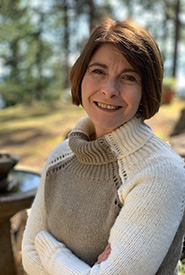Wildlife conservation starts on our doorstep
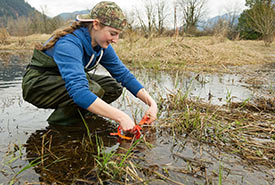
A high school student in a wetland, learning to identify egg masses of amphibian species in the Fraser Valley. (Photo by Isabelle Groc)
The IPBES 2019 Global Assessment Report on Biodiversity reported that one million species of plants and animals are threatened with extinction.
I am a mother, and as many others who interact with children and youth, I am worried about the world our young generations will face. When we are bombarded with daily headlines about ecological changes in every corner of the planet, it is easy to lose hope, to feel overwhelmed and powerless. What can we do to make a difference, and does it even matter?
Related content
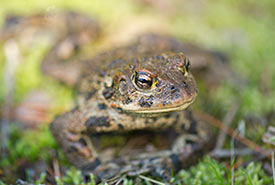
Adult western toad (Photo by Isabelle Groc)
I have spoken to many children and youth about the climate crisis and wildlife extinction and many experience a tremendous sense of anxiety, loss and grief. Yet I will continue to bring awareness to people of all ages about these issues, such as in a screening of my latest documentary Toad People at the Nature Conservancy of Canada’s NatureTalks event in Victoria, BC.
As adults, we may be tempted to avoid these discussions in an attempt to protect youth from the harsh realities, but young people are expecting more from us today and are engaging adults in unprecedented ways, leading climate marches and asking us to take action. Will and can we hear them?
Jamie Margolin, a 17-year old climate activist and the co-founder of the Zero Hour movement, said she grew up watching documentaries about environmental destruction that filled her “with fear and dread” for her future. “I wanted to act, but I didn’t know how. No one teaches young people how to act on an issue they care about,” she writes.
Jamie’s words resonate with my own experience as a child. When the tanker Amoco Cadiz ran aground off the coast of Brittany, the oil spill caused the largest loss of marine life ever recorded then. I was just a small child, but I vividly remember watching the images of oil-covered seabirds on TV. I asked my parents if I could leave school and go to Brittany to join the volunteers who were doing the cleanup. I lived in a small town in the southwest of France, I had never been to Brittany, I had never seen the ocean or a seabird, but it didn’t matter. I was desperate to act. Although at that tender age I could not do anything, this early experience had a profound impact on me and became the foundation for a lifelong commitment to photo-journalism, writing and filmmaking to document environmental changes and the plight of endangered wildlife around the world.
I believe we have a responsibility to empower and not overwhelm children and youth when considering wildlife extinction, and we can do this from a place of optimism and hope. Where do we start?
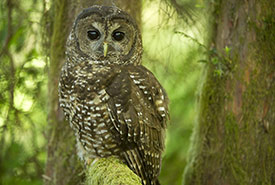
Spotted owl (Photo by Isabelle Groc)
I have lived in British Columbia for 20 years, and in that time, I have witnessed local species decline; northern spotted owls, mountain caribou, southern resident orcas come to mind. Extinction does not just happen in far corners of the world. This is the reality of species that live next door, in our province. This means that wildlife conservation also starts on our doorstep. Any step we can take to protect habitat and wildlife close to home makes a difference for these species and helps create global impact. As Jane Goodall says, “every single individual makes an impact on the planet — every single day.”
There are many steps that children and youth can take with the adults that matter in their lives to help the natural world close to where they live. They can join a citizen science project to help scientists collect information about local birds or amphibians; plant native vegetation to support pollinators; fundraise for a conservation cause; speak publicly for natural spaces and species; or enhance biodiversity in an urban park or community garden.
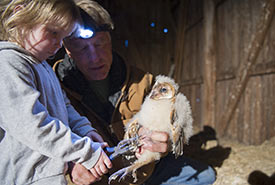
Bird bander Dick Clegg teaching his granddaughter to band owls in Chilliwack where he set up barn owl boxes. (Photo by Isabelle Groc)
Most importantly, it comes down to making nature a part of our lives. I live in Vancouver, and every time I am out for a walk, I take notice of the wildlife around me. I encourage my children to pay attention: noticing Anna’s hummingbirds visiting backyard feeders, watching a great blue heron hunt on the seawall or admiring a bald eagle perched on a tall tree near the beach. These sights inspire and enrich our hearts and souls.
Our busy lives do not leave us much time for nature, but we are in this together. There is a growing body of research showing that spending time in nature has tremendous benefits, and it may be time to rethink our children’s busy schedules to make room for nature in the calendar.
In the end, what I do with my children may not be enough. But we do what we can, as much as we can, and because others are also doing what they can as much as they can, together we can make a difference.
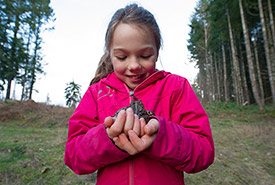
Daughter of a biologist who is surveying toads to better understand their winter habitat requirements. (Photo by Isabelle Groc)
Of course there are ups and downs, and when I need a morale boost, I think of my long-time conservation heroes, such as Jane Goodall and Virginia McKenna, who are inspiring guides in this journey. But there are many local heroes around us who take steps every day to save the local endangered wildlife and habitats they care about. My documentary Toad People tells the story of some of the extraordinary individuals who are taking action to save western toads and other threatened species across communities in British Columbia.
Toad People has resonated with audiences worldwide because it offers a human, accessible model upon which people can act; a global message of hope built from streams of local conservation actions.
We live in a very connected world, and while this connectivity can sometimes remove us from nature, it is also an opportunity to bring everyone together who cares about an issue. What we do on our doorstep for the natural world can be shared and amplified globally, and it can also give strength to others who are also taking action in their own communities. We are not alone.
Toad People will be screened at the Nature Conservancy of Canada's NatureTalks event on December 4, 2019 in Victoria, BC.

